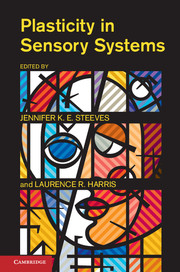Book contents
- Frontmatter
- Contents
- List of Contributors
- 1 Plasticity in Sensory Systems
- I VISUAL AND VISUOMOTOR PLASTICITY
- II PLASTICITY IN CHILDHOOD
- 5 Human Visual Plasticity: Lessons from Children Treated for Congenital Cataracts
- 6 Living with One Eye: Plasticity in Visual and Auditory Systems
- 7 Building the Brain in the Dark: Functional and Specific Crossmodal Reorganization in the Occipital Cortex of Blind Individuals
- 8 Crossmodal Plasticity in Early Blindness
- III PLASTICITY IN ADULTHOOD AND VISION REHABILITATION
- Author Index
- Subject Index
- References
6 - Living with One Eye: Plasticity in Visual and Auditory Systems
from II - PLASTICITY IN CHILDHOOD
Published online by Cambridge University Press: 05 January 2013
- Frontmatter
- Contents
- List of Contributors
- 1 Plasticity in Sensory Systems
- I VISUAL AND VISUOMOTOR PLASTICITY
- II PLASTICITY IN CHILDHOOD
- 5 Human Visual Plasticity: Lessons from Children Treated for Congenital Cataracts
- 6 Living with One Eye: Plasticity in Visual and Auditory Systems
- 7 Building the Brain in the Dark: Functional and Specific Crossmodal Reorganization in the Occipital Cortex of Blind Individuals
- 8 Crossmodal Plasticity in Early Blindness
- III PLASTICITY IN ADULTHOOD AND VISION REHABILITATION
- Author Index
- Subject Index
- References
Summary
When we look at our environment, we immediately detect and recognize they objects, buildings, and people surrounding us. Our perception of fine detail, lines, edges, color, movement, and depth are all important for building up representations of these objects, scenes, and people. This processing occurs rapidly and is achieved effortlessly by the visual system as we take in the world with both eyes. Imagine what it might be like to not have vision through two eyes – to be completely blind. We would have to use our remaining intact sensory systems to their fullest capacity in order to interact with the world. Our senses of touch, taste, smell, and hearing would become significantly more important to allow us to connect with and understand our world.
Now instead, consider what it might be like to lose vision in only one eye. With one completely nonfunctional eye and one intact eye, our visual system would still receive light input through the intact remaining eye. So, one might ask, how could having only one eye affect our ability to see? From a systems point of view, the physical light input to our visual system would be reduced by half compared to the intact binocular visual system.
- Type
- Chapter
- Information
- Plasticity in Sensory Systems , pp. 94 - 113Publisher: Cambridge University PressPrint publication year: 2012
References
- 2
- Cited by



